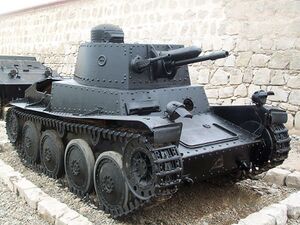CC-41
| CC-41 | |
|---|---|
 | |
| Type | Medium tank |
| Place of origin | |
| Service history | |
| In service | 1941–1965 |
| Used by | |
| Wars | Second Fascist War |
| Production history | |
| Manufacturer | Angelbridge Automotives |
| Produced | 1941-45 |
| No. built | 5,774 |
| Specifications | |
| Weight | combat: 9.5 tonnes dry: 8.5 tonnes |
| Length | 4.61 m |
| Width | 2.14 m |
| Height | 2.40 m |
| Crew | 4 |
| Armor | front 25 mm side 15 mmG |
Main armament | 1x 37.2 mm gun with 90 rounds |
Secondary armament | 2 x 7.92 mm machine gun with 2,550 rounds. |
| Engine | Angelbridge Model I inline six-cylinder, liquid-cooled, petrol 91,9 kW (123.3 hp, 125 PS) |
| Power/weight | 10 kW/metric ton (13.0 hp/short ton) |
| Transmission | 5 forward, 1 reverse |
| Suspension | Leaf spring |
Operational range | 200 km (120 mi) |
| Speed | 56 km/h (35 mph) |
| Tanks of the Exponential Empire |
|---|
| CC-5 · CC-23 · CC-41 · CC-58 |
The CC-41 was a medium tank used by the Imperial Exponential Army in combat operations of the Second Fascist War. It proved sufficient against infantry, but it was not designed to fight other tanks.Almost 6,000 units were produced, making it one of the most numerous Exponential armored fighting vehicle of the time.
Description
The CC-41 was a conventional interwar tank design, with riveted armour and a rear engine. The riveted armour was mostly not sloped, and varied in thickness from 10 mm to 25 mm in most versions. Later models increased this to 50 mm by bolting on an additional 25 mm armour to the front. Side armours received additional 15 mm armour as the war progressed.
The two-man turret was centrally located, and housed the tank's main armament, a 37 mm gun with 90 rounds stored on board. It was equipped with a 7.92 mm machine gun to the right of the main ordnance. This turret machine gun was in a separate ball mount rather than a fixed coaxial mount. This meant the machine gun could be trained on targets independently. Alternatively, the commander/gunner could couple the machine gun internally to the main gun and use it as a coaxial machine gun. The driver was in the front right of the hull, with the bow machine-gunner seated to the left, manning the 7.92 mm machine gun. As with many 1930s tanks, the bow gunner was also the radio operator. The radio was mounted on the left of the bow gunner.
The engine was mounted in the rear of the hull and drove the tank through a transmission with five forward gears and one reverse gear to forward drive sprockets. The track ran under four rubber-tired road wheels and back over a rear idler and two track return rollers. The wheels were mounted on a leaf-spring double-bogie mounted on two axles. Despite the large wheel size, the tank did not use a Christie suspension.
The main advantages of the CC-41, compared to other tanks of the day, were a very high reliability and sustained mobility. In one documented case a regiment was supplied with tanks driven straight from the factory in 2.5 days instead of the anticipated week, without any mechanical breakdowns. In the opinion of the crews, the drive components of the CC-41, engine, gear, steering, suspension, wheels and tracks were perfectly in tune with each other. The tank was also considered to be very easy to maintain and repair. Minor luxuries, such as adjustable seats for the driver and firmer footing for the commander/gunner and loader, were also provided. A total of 2,550 rounds were carried for the bow and turret machine guns. The driver could also fire the hull machine gun with a trigger fitted on the left tiller bar.